How tech leaders can develop an IT sustainability plan
Sustainability is on many tech leaders' minds, but knowing where to start can be daunting. CIO Niklas Sundberg shares his experience building an IT sustainability plan.
Implementing sustainable practices in an organization's IT department can seem like an insurmountable task. For some, it could mean reevaluating or eliminating tools and practices already in place, but for others, it could mean a complete companywide reorganization.
Regardless of where you start on your sustainability journey, it takes time, effort and guidance to create a plan -- which is where Niklas Sundberg's Sustainable IT Playbook for Technology Leaders comes in.
Sundberg, senior vice president and CIO at Assa Abloy Global Solutions, was inspired to write the book when he began his own sustainability journey and found a lack of resources for technology leaders on how to create a sustainable IT agenda.
Questions loomed as to where to start, what key areas to focus on and how to establish a baseline. This motivated Sundberg to create a playbook that IT leaders could use to quickly begin addressing key areas, such as cloud and data center energy use, IT hardware management, and sustainable IT procurement.
Beginning a sustainable IT journey
In the Sustainable IT Playbook, Sundberg aims to provide tech leaders with the tools to plan, implement and communicate a thorough sustainable IT strategy -- and, in doing so, set themselves apart from their competitors.
The book is divided into three focus areas: the why, what and how of delivering sustainable IT at an organizational level. Part 1 explains what climate change is and why sustainable IT is important, particularly in light of technology's role in the climate crisis.
 Niklas Sundberg
Niklas Sundberg
"[The tech sector] is a major contributor to the depletion of the world's resources and the consumption of energy," Sundberg said. For that reason, he wanted to make it clear to IT leaders that this is already a major problem that will only get worse if action is not taken.
For example, e-waste from servers, end-user devices and network equipment creates the biggest waste stream in the world at 57 million tons annually. In addition, rapid advancements in analytics, AI, machine learning and storage mean that the energy consumption of the information and communications technology sector could increase significantly by 2030, Sundberg said.
To begin addressing these issues, Sundberg provides examples in the book of what sustainable IT practices could look like in areas such as IT hardware management, energy resource management, leveraging buying power and sustainability by IT. Using these building blocks, organizations can then create a strategy based on their own resources and needs.
This foundation includes Sundberg's sustainable IT maturity model, which focuses on commitment, governance, processes and tools, people and the organization, and performance management. This assessment framework includes five maturity levels intended to help organizations judge their starting point, identify gaps and determine the specifics of implementation.
Implementation difficulties
Even with all the knowledge and statistics at hand, taking action at an organizational level can be challenging. The most difficult part, in Sundberg's experience, has been dealing with the impact of IT hardware.
Data centers are one of the most resource-intensive operations that must be addressed. According to Sundberg, data centers today emit the same amount of carbon dioxide (CO2) as the global aviation industry -- and their emissions could be six times the current level by 2030. Many organizations are moving to the cloud to alleviate that burden and meet their sustainability goals.
Sundberg recommends implementing circular economy practices to help reduce waste and promote resource efficiency -- through, for example, the product-as-a-service model.
"If you start applying circular business practices regarding how you manage your hardware, for example, then in a best-case scenario, you can probably get to a 50% reduction on your CO2 emissions from your IT hardware," Sundberg said. "I think the biggest challenge that I see is, how do you reduce the remaining 50%?"
To help eliminate the remaining emissions, Sundberg said IT buyers must put more pressure on hardware vendors to enforce sustainability requirements when creating products or upgrading components to reduce carbon emissions.
"We need to collectively work together with hardware vendors to introduce a lot more circularity and a more modular approach in terms of upgrading certain components within the hardware," Sundberg said. For example, vendors could replace an old battery in a smartphone instead of providing an entirely new phone.
Taking the first step
With all these considerations in mind, Sundberg's advice for IT managers is to first establish a CO2 baseline when creating a plan and use that knowledge as a guide for where to go next.
Sundberg's Sustainable IT Playbook is accompanied by a website code that includes additional resources, such as an Excel spreadsheet that readers can download to help calculate their baseline. This exercise can help organizations better understand their IT assets and identify key areas to address.
From there, Sundberg said, organizations should focus on automation and analytics tools that can digest data automatically and build a data warehouse. He also recommended performing simulations to forecast the effects of taking various actions to promote sustainability.
Though individual actions can seem small, implementing sustainable IT has the potential to drive positive change. "I think the great thing about working in tech is that everything we do is on a global scale," Sundberg said, "so it also has global impact."
Download the PDF to read Part 1, Section 2 ("Rise of Sustainable IT") of Sustainable IT Playbook for Technology Leaders. This section focuses on the main drivers of a sustainable IT plan as well as environmental, social and governance considerations for IT. The book was released in October 2022 and published with Packt Publishing, ISBN: 978-1803230344.
http://sustainableitplaybook.com/








